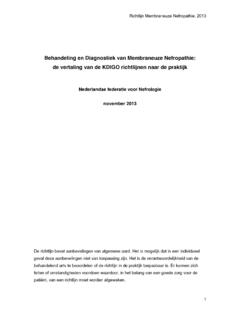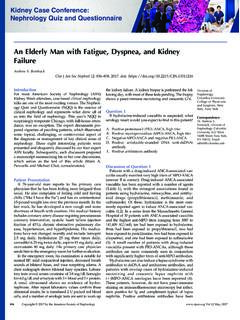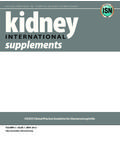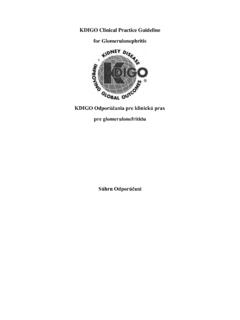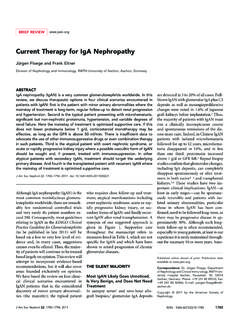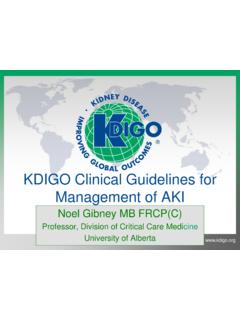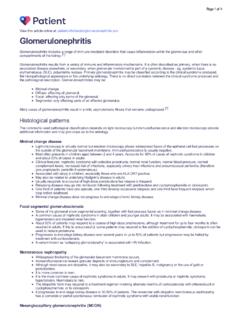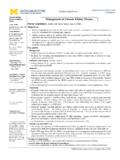Transcription of NfN Richtlijn Lupus Nefritis februari 2014
1 NfN Richtlijn Lupus Nefritis februari 2014 Verantwoordelijk lid NfN kwaliteitscommissie: Mw dr A van Tellingen, De Richtlijn bevat aanbevelingen van algemene aard. Het is mogelijk dat in een individueel geval deze aanbevelingen niet van toepassing zijn. Het is de verantwoordelijkheid van de behandelend arts te beoordelen of de Richtlijn in de praktijk toepasbaar is. Er kunnen zich feiten of omstandigheden voordoen waardoor, in het belang van een goede zorg voor de pati nt, van een Richtlijn moet worden afgeweken. Richtlijn Lupus Nefritis , NfN, 2014 2 Voorwoord Deze Richtlijn is gebaseerd op de kdigo (Kidney Disease Improving Global outcomes) clinical Practice guidelines for glomerulonephritis , Chapter 12: Lupus nephritis.
2 In het voorliggende document is alleen de kdigo samenvatting opgenomen met de aanbevelingen. Voor de uitgebreide onderbouwing van de richtlijnen raadplege men de volledige Richtlijn , gepubliceerd in Kidney International Supplements 2012;2:221-232, en op De kdigo Richtlijn is door de Landelijke Werkgroep Systemische Lupus Erythematosus en subcommissie van de NfN kwaliteitscommissie beoordeeld. Waar nodig heeft de Werkgroep en subcommissie commentaar of aanvulling op de kdigo Richtlijn gegeven. Het commentaar en aanvullingen zijn gebaseerd op drie andere richtlijnen welke onlangs zijn gepubliceerd: Van Tellingen A, Voskuyl AE, Vervloet MG, et al.
3 Dutch guidelines for diagnosis and therapy of proliferative Lupus nephritis, The Netherlands Journal of Medicine 2012;70:199-207 namens de Landelijke Werkgroep Systemische Lupus Erythematosus, Hahn BH, McMahon MA, Wilkinson A, et al. American College of Rheumatology guidelines for screening, treatment and management of Lupus nephritis. Arthritis Care and Research 2012;64:797-808 Bertsias GK, Tektonidou M, Amoura A, et al. Joint European League Against Rheumatism and European Renal Association (EULAR/ERA-EDTA) recommendations for the management of adult and paediatric Lupus nephritis.
4 Annuals Rheum Disease 2012;71:1771-1782 In de appendix, blz 16 is toegevoegd het advies van de Landelijke werkgroep SLE betreffende het verrichten van een nierbiopsie bij pati nten met Lupus Nefritis , NfN, 2014 3 kdigo clinical Practice Guideline for glomerulonephritis The 2011 Kidney Disease: Improving Global Outcomes ( kdigo ) clinical Practice Guideline for glomerulonephritis (GN) aims to assist practitioners caring for adults and children with GN. Guideline development followed an explicit process of evidence review and appraisal. Treatment approaches are addressed in each chapter and guideline recommendations are based on systematic reviews of relevant trials.
5 Appraisal of the quality of the evidence and the strength of recommendations followed the GRADE approach. (zie bijlage blz 13) Chapter 12: Lupus nephritis Summary of recommendation statements : Class I LN (minimal-mesangial LN) : We suggest that patients with class I LN be treated as dictated by the extrarenal clinical manifestations of Lupus . (2D) Rationale Class I LN has no clinical kidney manifestations. Class I LN is not associated with long-term impairment of kidney function. Comment There are no data to suggest that treatment of class I LN is indicated, unless necessitated by extra-renal Lupus activity.
6 However, the EULAR-EDTA recommendations establish that in cases of class I LN with podocytopathy on the electron microscopy (minimal change nephropathy) or with interstitial nephritis, corticosteroids alone or in combination with immunosuppressive agents may be considered. The Dutch Working Party on SLE supports this advice. : Class II LN (mesangial-proliferative LN) : Treat patients with class II LN and proteinuria <1 g/d as dictated by the extra-renal clinical manifestations of Lupus . (2D) : We suggest that class II LN with proteinuria >3 g/d be treated with corticosteroids or CNIs as described for minimal change nephropathy.
7 (2D) Rationale There are no evidence-based data on the treatment of class II LN. Podocytopathies, characterized histological by diffuse foot process effacement in the absence of glomerular capillary wall immune complex deposition or endocapillary proliferation, have been observed in patients with class II LN. Comment There is no prospective study on the treatment of nephrotic range proteinuria in class II LN. However, the kdigo guideline mentions that it is reasonable to treat these patients as for MCD/FSGS in case of nephrotic syndrome, or if proteinuria cannot be controlled using RAS Richtlijn Lupus Nefritis , NfN, 2014 4 blockade.
8 In addition, The EULAR-EDTA guideline recommends low-to moderate doses of corticosteroids alone or in combination with azathioprine if proteinuria > 1 g/day persists despite RAS-blockade and salt restriction, especially in the presence of glomerular hematuria. Both recommendations are not graded. The Dutch Working Party on SLE supports the EULAR/EDTA recommendation. We also recommend that treating physicians are watchful for signs of conversion to proliferative forms of Lupus nephritis. : Class III LN (focal LN) and class IV LN (diffuse LN) initial therapy : We recommend initial therapy with corticosteroids (1A), combined with either cyclophosphamide (1B) or MMF (1B).
9 : We suggest that, if patients have worsening LN (rising SCr, worsening proteinuria) during the first 3 months of treatment, a change be made to an alternative recommended initial therapy, or a repeat kidney biopsy be performed to guide further treatment. (2D) Rationale Proliferative LN (class III or IV) is an aggressive disease. Patient and kidney survival in class III and IV LN have dramatically improved through the use of intensive immunosuppression. The treatment recommendations are for active or active plus chronic lesions, based on the International Society of Nephrology/Renal Pathology Society classification of LN.
10 The term initial treatment is preferred. The evolution of initial therapy in proliferative LN has been to reduce toxicity while maintaining efficacy. The efficacy of newer initial treatment regimens should be assessed not only by initial responses, but also by long-term effects on kidney relapse, and development of chronic kidney disease. Comment The results of the Euro- Lupus Nephritis trial showed that the low-dose iv cyclophosphamide (500 mg fixed dose, six pulses every two weeks) in combination with methylprednisolon (three days, 750 mg) achieves good clinical results in the long-term in a European (mainly Caucasian) population with a moderately severe disease.
